Introduction:
Chart widgets are indispensable tools used in various trading platforms to provide traders with visual representations of market data. These widgets are designed to offer real-time or historical information that helps traders analyze price movements, identify trends, and make informed trading decisions. In this article, we will delve into the general description of what a chart widget is and how it contributes to enhancing the trading experience.
What is a Chart Widget?
A chart widget, also known as a trading chart or graph, is an interactive graphical representation of financial data. It displays the price movements of an asset over a specific time period. Chart widgets come in various forms, such as candlestick charts, line charts, bar charts, and more. Traders can choose the chart type that suits their trading style and preferences.
Key Features of Chart Widgets:
- Real-time Data: Chart widgets provide traders with live data feeds, allowing them to see the most up-to-date information about the market. Real-time data is crucial for accurate analysis and timely decision-making.
- Customizable Time Frames: Traders can adjust the time frame displayed on the chart widget according to their trading strategy. They can analyze price movements over minutes, hours, days, weeks, or even years, depending on their requirements.
- Technical Indicators: Chart widgets often offer a wide range of technical indicators that assist traders in analyzing price patterns, identifying trends, and predicting future market movements. Common indicators include moving averages, Bollinger Bands, Relative Strength Index (RSI), and many more.
- Drawing Tools: To further enhance the analytical capabilities of traders, chart widgets often provide drawing tools. These tools enable users to draw trend lines, support and resistance levels, and other visual indicators directly on the chart, aiding in better decision-making.
- Multiple Asset Classes: Chart widgets cover a broad range of asset classes, including stocks, commodities, forex, cryptocurrencies, and indices. Traders can easily switch between different assets and compare their price movements on a single chart widget.
Benefits of Using Chart Widgets in Trading:
- Enhanced Visual Analysis: Chart widgets provide traders with a visual representation of market data, enabling them to identify trends and patterns more easily.
- Informed Decision-making: By analyzing the price movements and using technical indicators, traders gain insights into the market conditions, which helps them make informed trading decisions.
- Efficient Time Management: Real-time data and customizable time frames allow traders to quickly assess the market situation, saving time on manual analysis.
- Personalized Trading Strategies: Chart widgets offer customization options, allowing traders to align the display and functionality according to their trading strategies and preferences.
Conclusion:
Chart widgets serve as indispensable tools for traders, offering real-time market data, customizable time frames, technical indicators, and drawing tools. By utilizing these features, traders can effectively analyze price movements, identify trends, and make informed decisions. Having a good understanding of chart widgets and utilizing them efficiently can significantly enhance a trader’s overall trading experience and potential for success.

